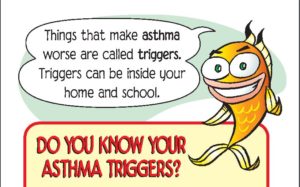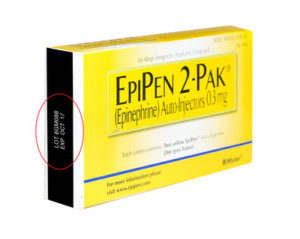Are You Prepared for Hurricane Season?
With June 1st being the beginning of hurricane season, what’s a better time to discuss how to protect yourself and your family from asthma triggers after a hurricane or tropical storm? Hurricanes produce high winds which blow pollen and mold spores into the air that can make asthma symptoms worse. During these times people with asthma can experience wheezing, coughing, tightness in the chest, and other complications with breathing. Here are a few tips to help prevent asthma attacks during the upcoming hurricane season.

Avoid Homes or Buildings with Suspected Mold Damage
Once any flooding clears and the cleanup process begins people with asthma are at risk of exposure to mold and dust. In extreme cases it is best to not even enter a building or home that has mold growth that you can see or smell. But if you have to be exposed to these conditions, protect yourself by wearing a filtering mask, rubber gloves, and eye protection.
Coping with Stress and Emotion
During the aftermath of a hurricane, stress levels are high and they can trigger an attack. That’s why it is best to take care of your emotional state of mind during these stressful times. Communicate and connect with other people and seek help if needed.
Washing Hands

Keeping your hands clean can help prevent the spread of germs. In many cases catching a cold or the flu can also trigger an asthma attack. If safe water is unavailable on a temporary basis use hand sanitizer.
Stock Up on Asthma Medications
Most importantly always have your asthma medication on hand and use as prescribed or when needed to control your asthma attacks. Consider storing medication and important documents in a waterproof container.
What About Climate Change?
Climate change may play a major factor in increasing allergies and asthma triggers. Rising temperatures lead to longer allergy seasons which can make the air quality worse. A warming climate also increases ground level ozone levels. This pollutant is considered to be one of the biggest hazards to people with asthma. It causes shortness of breath, coughing, aggravates lung diseases, and increases the frequency of asthma attacks.
Additional Resources
Helpful Links – Post Hurricane – Indoor Air Quality
What Climate Change Means for Allergy Season



















 Well controlled asthma means that your child is in the GREEN zone of the asthma action plan. Good control implies that your child’s symptoms such as coughing, wheezing or shortness of breath occur only two or fewer days per week.
Well controlled asthma means that your child is in the GREEN zone of the asthma action plan. Good control implies that your child’s symptoms such as coughing, wheezing or shortness of breath occur only two or fewer days per week. 
 When you step outside and take a deep breath in cold air – it’s shocking – you feel like you can’t take a deep breath. While breathing in cold air can be uncomfortable for anyone, people who suffer from asthma need to be more cautious.
When you step outside and take a deep breath in cold air – it’s shocking – you feel like you can’t take a deep breath. While breathing in cold air can be uncomfortable for anyone, people who suffer from asthma need to be more cautious.  We hear all the time from multiple sources to get more exercise. Everyone has their reasons for not getting enough. We all know we should do it more, but feel like we don’t have enough time or energy to do so. If you suffer from asthma, you may fear that working out would make your symptoms worse. Here are some of the best options for exercising with asthma
We hear all the time from multiple sources to get more exercise. Everyone has their reasons for not getting enough. We all know we should do it more, but feel like we don’t have enough time or energy to do so. If you suffer from asthma, you may fear that working out would make your symptoms worse. Here are some of the best options for exercising with asthma Asthma is a challenging, but very treatable illness. There are many medications and tools available to help relieve symptoms. Did you know that asthma prevention can start in your kitchen? Not all foods are created equal. What foods might be best for asthmatics? There are even healthy foods that may worsen your asthma symptoms.
Asthma is a challenging, but very treatable illness. There are many medications and tools available to help relieve symptoms. Did you know that asthma prevention can start in your kitchen? Not all foods are created equal. What foods might be best for asthmatics? There are even healthy foods that may worsen your asthma symptoms. Music is a wonderful stress release for many people. For some, the release comes from listening to the music and relating to the lyrics. It strikes a chord inside of us all. For others, making music is the release. Whether you play an instrument or sing, you are successfully dissolving the stress of your day-to-day. Congratulations! You have found an outlet.
Music is a wonderful stress release for many people. For some, the release comes from listening to the music and relating to the lyrics. It strikes a chord inside of us all. For others, making music is the release. Whether you play an instrument or sing, you are successfully dissolving the stress of your day-to-day. Congratulations! You have found an outlet. Summer is coming to a close for students in North Carolina. The change of seasons and environment can spell trouble for asthma and allergy sufferers. They already know their at-home triggers and how to combat them, but have less control over their environment at school. Common classroom triggers include pollen, dust mites, mold, chalk dust, and pet dander. With the help of school administrators and parents, students can remain focused on their studies and less on their allergies.
Summer is coming to a close for students in North Carolina. The change of seasons and environment can spell trouble for asthma and allergy sufferers. They already know their at-home triggers and how to combat them, but have less control over their environment at school. Common classroom triggers include pollen, dust mites, mold, chalk dust, and pet dander. With the help of school administrators and parents, students can remain focused on their studies and less on their allergies.

 Food industry workers at a microwave popcorn factory were the first to get sick from inhaling the vapors from artificial flavorings. The vapors caused symptoms such as coughing, wheezing, and shortness of breath, similar to those of chronic obstructive pulmonary disease (COPD).
Food industry workers at a microwave popcorn factory were the first to get sick from inhaling the vapors from artificial flavorings. The vapors caused symptoms such as coughing, wheezing, and shortness of breath, similar to those of chronic obstructive pulmonary disease (COPD). Plants are frequently used to mediate the effects of pollution and toxins in our external environment. Our indoor environments can contain toxins such as volatile organic compounds (VOCs). Two common indoor VOC pollutants are benzene and formaldehyde. Benzene can be found in plastics, fabrics, pesticides, and cigarette smoke. Common household items such as dish detergent, fabric softener, and carpet cleaners all may contain formaldehyde.
Plants are frequently used to mediate the effects of pollution and toxins in our external environment. Our indoor environments can contain toxins such as volatile organic compounds (VOCs). Two common indoor VOC pollutants are benzene and formaldehyde. Benzene can be found in plastics, fabrics, pesticides, and cigarette smoke. Common household items such as dish detergent, fabric softener, and carpet cleaners all may contain formaldehyde.
 Spring is in the air, and as temperatures rise, an asthmatic’s symptoms reach their peak.
Spring is in the air, and as temperatures rise, an asthmatic’s symptoms reach their peak.  It’s no secret that tobacco is one of the most common asthma triggers. Tobacco smoke irritates the airways and causes your lungs to produce more mucus. In addition, it weakens the tiny hairs called cilia that sweep away mucus and other irritants that settle in your airways.
It’s no secret that tobacco is one of the most common asthma triggers. Tobacco smoke irritates the airways and causes your lungs to produce more mucus. In addition, it weakens the tiny hairs called cilia that sweep away mucus and other irritants that settle in your airways. Most people are aware of the most common asthma triggers which are referred to as the 3 Ps: pets, pollen, and pollution. Recent studies have brought a new one to light – sugar. The reason? Sugar causes inflammation of the airways. I bet you didn’t know that a little sugar could cause such a reaction.
Most people are aware of the most common asthma triggers which are referred to as the 3 Ps: pets, pollen, and pollution. Recent studies have brought a new one to light – sugar. The reason? Sugar causes inflammation of the airways. I bet you didn’t know that a little sugar could cause such a reaction. January is the height of flu season, and if you haven’t been vaccinated, it’s not too late to do so.
January is the height of flu season, and if you haven’t been vaccinated, it’s not too late to do so. 

 Over the last two decades, asthma and obesity have reached epidemic proportions. Obesity is a common comorbidity to asthma and it is commonly thought that obesity precedes the asthma symptoms. Now, the question has been raised about whether it is the other way around. Does obesity follow on the heels of asthma or is it asthma that raises the likelihood of becoming overweight?
Over the last two decades, asthma and obesity have reached epidemic proportions. Obesity is a common comorbidity to asthma and it is commonly thought that obesity precedes the asthma symptoms. Now, the question has been raised about whether it is the other way around. Does obesity follow on the heels of asthma or is it asthma that raises the likelihood of becoming overweight?









